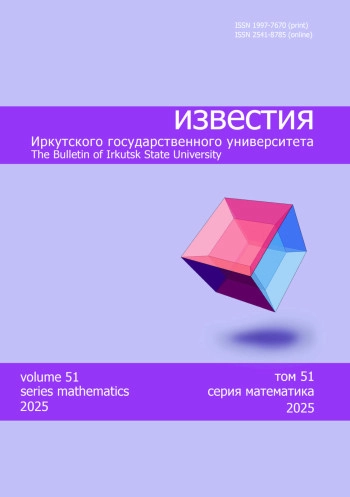Статьи в выпуске: 11
Статья посвящена научной и научно-педагогической деятельности члена-корреспондента Российской академии наук А. А. Толстоногова, которому в марте 2025 г. исполняется 85 лет.
Исследуется область теории нечетких моделей. Вводится понятие согласованного означивания предложений данной сигнатуры, которое можно рассматривать как обобщение на нечеткий случай понятия совместного множества предложений. По аналогии с классическим случаем рассматриваются классы нечетких моделей, порожденных согласованными означиваниями, вводится понятие аксиоматизированного класса нечетких моделей. Нечеткие значения истинности различных предложений можно рассматривать как формализацию субъективных оценочных знаний экспертов о предметной области. Для формализации таких знаний рассматриваются интервальные и точечные означивания, описываются теоретико-модельные свойства классов нечетких моделей, порожденных такими означиваниями. Зачастую при формализации некоторой системы необходимо также учитывать и среду, в которой находится данная система, и с которой она неизбежно взаимодействует (например, при реализации квантовых вычислений). В этом случае в нечеткую модель необходимо включать формализацию знаний не только о самой системе, но и о среде, в которой она обитает. Саму же систему можно рассматривать как подмодель полной модели. Вводится понятие подмодели нечеткой модели и факторизации класса нечетких моделей по фиксированным подмоделям. Доказывается, что классы эквивалентности такой факторизации являются аксиоматизированными классами нечетких моделей.
Изучается нетранзитивная временная мультиагентная логика с мультиозначиваниями агентов для переменных и формул. Ранее время и знания моделировались с помощью моделей Крипке, структура которых выглядела как простой единый временной кластер с множеством отношений достижимости для агентов. Здесь мы развиваем этот подход и используем модели Крипке, которые представляют собой линейное нетранзитивное время и состояния, представленные произвольными временными кластерами для мультиотношений достижимости агентов. Эта логика определяется семантически как множество формул, истинных на линейных моделях с мультиозначиваниями переменными и кластерами состояний. Мы предлагаем обоснование такого подхода и методику вычисления истинностных значений формул. Основные результаты касаются проблемы разрешимости. Мы доказываем, что полученная логика разрешима и финитно аппроксимируема.
Исследуется критерий полноты на множестве мультиопераций ранга 3 относительно оператора импликативного замыкания. Задача является частным случаем проблемы конечной классификации мультиопераций, заданных на произвольном множестве. Получено описание всех предполных множеств. Описаны выразительные возможности оператора, в том числе найдены условия, при которых множество операций импликативно порождает все множество мультиопераций. Полученный результат может быть использован при изучении мультиопераций, заданных на произвольном множестве.
Logical-probabilistic machine learning (LPML) is an AI method able to explicitly work with a priori knowledge represented in data models. This feature significantly complements traditional deep learning knowledge acquiring. Object ontologies are a promising example of such a priori models. They are an expanded logical analog of object oriented programming models. While forming the core of the bSystem platform, object ontologies allow solving the applied problems of high complexity, in particular, in the field of management. The combination of LPML and object ontologies is capable of solving the forecasting problems, the tasks of automated control, problem detection, decision making, and business process synthesis. The proximity of object ontologies to the LPML formalism due to the same semantic modeling background makes it possible to integrate them within a single hybrid formal system, which is presented in this paper. In the paper we introduce the approach to integration of these two formalisms and provide some algorithmic basis for the implementation of the resulting hybrid formalism on the bSystem platform.
Найдены необходимые и достаточные условия регулярности силовской p-подгруппы P группы Шевалле типа F4 или E6, определенной над кольцом классов вычетов целых чисел по модулю pm, когда простое число p отлично от 37, 41, 43, 47. Для перечисленных значений p группа P регулярна, если экспонента m не превосходит числа 3; при m больше, чем 3, ответ остается неизвестным.
Выявлены вогнутые продолжения дискретных функций, определенных на вершинах n-мерного единичного куба, n-мерного произвольного куба и n-мерного произвольного параллелепипеда. Конструктивно доказано, что, во-первых, любая дискретная функция fD, определенная на вершинах G - одного из этих трех множеств, имеет бесконечно много вогнутых продолжений на G и, во-вторых, существует функция fNR, являющаяся минимумом среди всех ее вогнутых продолжений на G. Также доказано, что функция fNR на G непрерывна и единственна.
Megumi Saigo derived generalized fractional operators, involving Gauss hypergeometric function, having four special cases: Riemann-Liouville, Weyl, Erdely-Kober left and right sided fractional operators. Mridula Garg and Lata Chanchalani established q-analogues of Saigo fractional integral operators. Building upon this base, the current article aims to generalize Saigo integral operators as well their q-analogues. In addition, we obtain some new results involving extended Saigo integral operators and their q-extensions.
This article discusses the existence of positive solutions to Sturm-Liouville boundary value problems for Riemann-Liouville nabla fractional difference equations. The results obtained here shall generalize the existing ones. We provide a few examples to illustrate the applicability of established results.
In this paper we investigate the existence of hyperbolic, Euclidean and spherical structures on cone-manifolds with underlying space 3-sphere and with singular set a given two-bridge knot. For two-bridge knots with 8 crossings we present trigonometric identities involving the length of singular geodesics and cone angles of such cone-manifolds. Then these identities are used to produce exact integral formulae for the volume of the corresponding cone-manifold modeled in the hyperbolic space.
Изучается линейная ситуация в условиях ограничения управления транспортными условиями с соблюдением границ границ границ опеременных борелевских мер. Для этой задачи впервые получен вариант классического принципа Понтрягина (в принципе принципа минимума) и предложен подход к его усилению на основе нестандартной процедуры вариационного анализа - точных формул приращения, представляющих разность показателей целевого функционала на любых паре допустимых управлений, без пренебрежения остаточных составляющих каких-либо разложений. Подход основан на стандартной двойственности и приводит к ряду необходимых условий обеспечения неклассического, «позиционного» типа. Конструктивным обоснованием позиционных условий является метод последовательных приближений, свободный от параметров «глубина снижения».











